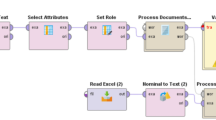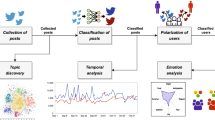Abstract
Increasing popularity of social networking sites like facebook, twitter, google+ etc. is contributing in fast proliferation of big data. Amongst social Networking sites, twitter is one of the most common source of big data where people from across the world share their views on various topics and subjects. With daily Active user count of 100-million+ users twitter is becoming a rich information source for finding trends and current happenings around the world. Twitter does provide a limited “trends” feature. To make twitter trends more interesting and informative, in this paper we propose a framework that can analyze twitter data and classify tweets on some specific subject to generate trends. We illustrate the use of framework by analyzing the tweets on “Politics” domain as a subject. In order to classify tweets we propose a tweet classification algorithm that efficiently classify the tweets.






Similar content being viewed by others
References
Twitter-Wikipedia. https://en.wikipedia.org/wiki/Twitter. Accessed Jan 27 2017
TweetStats. http://www.tweetstats.com/. Accessed Jan 27 2017
Xefer. https://xefer.com/twitter/. Accessed Jan 27 2017
TweetPsych.http://www.tweetpsych.com/. Accessed Jan 27 2017
Twitalyzer. https://twitter.com/twitalyzer. Accessed Jan 27 2017
Sentiment140 http://www.sentiment140.com/. Accessed Jan 27 2017
Tweet Archivist http://www.tweetarchivist.com/. Accessed Jan 27 2017
Twitonomy. http://www.twitonomy.com/. Accessed Jan 27 2017
Twitter Counter. https://twittercounter.com/. Accessed Jan 27 2017
Blei DM, Ng AY, Jordan MI (2003) Latent dirichlet allocation. J Mach Learn Res 3:993–1022
Mcauliffe JD, Blei DM (2008) Supervised topic models. In: Advances in neural information processing systems, pp. 121–128
Lacoste-Julien S, Sha F, ordan MI (2009) DiscLDA: discriminative learning for dimensionality reduction and classification. In: Advances in neural information processing systems, pp. 897–904
Ramage D, Hall D, Nallapati R, Manning CD (2009) Labeled LDA: a supervised topic model for credit attribution in multi-labeled corpora. In: Proceedings of the 2009 conference on empirical methods in natural language processing: vol 1, Association for Computational Linguistics, pp. 248–256
Zhao WX, Jiang J, Weng J, He J, Lim EP, Yan H, Li X (2011) Comparing twitter and traditional media using topic models. In: European conference on information retrieval, Springer Berlin Heidelberg, pp. 338–349
Lau JH, Collier N, Baldwin T (2012) On-line trend analysis with topic models:\# twitter Trends Detection Topic Model Online. In: COLING, pp. 1519–1534
Sriram B, Fuhry D, Demir E, Ferhatosmanoglu H, Demirbas M (2010) Short text classification in twitter to improve information filtering. In: Proceedings of the 33rd international ACM SIGIR conference on research and development in information retrieval, ACM, pp. 841-842
Banerjee S, Ramanathan K, Gupta A (2007) Clustering short texts using wikipedia. In: Proceedings of the 30th annual international ACM SIGIR conference on research and development in information retrieval, ACM, pp. 787–788
Lin J, Snow R, Morgan W (2011) Smoothing techniques for adaptive online language models: topic tracking in tweet streams. In: Proceedings of the 17th ACM SIGKDD international conference on Knowledge discovery and data mining, ACM, pp. 422–429
Allan J (ed) (2012) Topic detection and tracking: event-based information organization, vol 12. Springer Science and Business Media, Berlin
Varga A, Basave AEC, Rowe M, Ciravegna F, He Y (2014) Linked knowledge sources for topic classification of microposts: a semantic graph-based approach. Web Semantics Sci Serv Agents World Wide Web 26:36–57
Kinsella S, Passant A, Breslin JG (2011) Topic classification in social media using metadata from hyperlinked objects. In: European conference on information retrieval, Springer Berlin Heidelberg, pp. 201–206
Lee K, Palsetia D, Narayanan R, Patwary MMA, Agrawal A, Choudhary A (2011) Twitter trending topic classification. In: 2011 IEEE 11th international conference on data mining workshops, IEEE, pp. 251-258
Yerva SR, Miklós Z, Aberer K (2011) What have fruits to do with technology?: the case of orange, blackberry and apple. In: Proceedings of the international conference on web intelligence, mining and semantics, ACM, p. 48
Yamin M, Ammar A. Al Makrami (2015) Cloud Computing in SMEs: case of Saudi Arabia. BVICAM’s Int J Inf Technol 7(1):853–860
Suneel KS, Guruprasad HS (2016) An approach for server consolidation in a priority based cloud architecture. BVICAM’s Int J Inf Technol 8(1):934–939
Beigh BM (2015) Framework for choosing best intrusion detection system. BIJIT-BVICAM’s Int J Inf Technol 4852:821
Kishore N, Seema S (2016) Secured data migration from enterprise to cloud storage–analytical survey. BVICAM’s Int J Inf Technol 8(1):965–968
Rana V (2013) Innovative use of cloud computing in smart phone technology. BVICAM’s Int J Inf Technol 5(2):640
Author information
Authors and Affiliations
Corresponding author
Rights and permissions
About this article
Cite this article
Khan, I., Naqvi, S.K., Alam, M. et al. An efficient framework for real-time tweet classification. Int. j. inf. tecnol. 9, 215–221 (2017). https://doi.org/10.1007/s41870-017-0015-x
Received:
Accepted:
Published:
Issue Date:
DOI: https://doi.org/10.1007/s41870-017-0015-x




